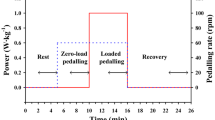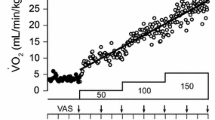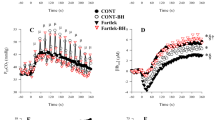Abstract.
Since dyspnoeic sensation (δ) increases progressively with work rate (WR) and the duration of a volitional breath-hold (t BH) shortens, we wished to explore whether t BH might correlate sufficiently closely with δ to provide a quantitative and descriptor-free index of respiratory sensation during dynamic exercise. Nine healthy males exercised on a cycle ergometer at a series of constant WRs, above and below the lactate threshold. Ventilatory and gas exchange variables were measured breath-by-breath. At each WR, breath-holds to the limit of tolerance were taken; δ was recorded (visual-analog scale) immediately prior to and throughout each breath-hold. During breath-holds, δ increased with time as a "break-away" monoexponential characteristic, reaching the maximum (100%) at the break-point. Despite end-tidal partial pressure of carbon dioxide at the break-point being higher and end-tidal partial pressure of oxygen being lower with increasing WR, the relationship between WR and t BH declined curvilinearly (i.e. with large falls in t BH occurring in the low WR range, but far smaller reductions at higher WRs). The t BH/minute ventilation relationship had a similar form. The relationship between pre-breath-hold δ and t BH was also complex: the large reductions in t BH in the low WR range were associated with only modest increases in pre-BH δ while, at higher WRs, the progressively smaller decrements in t BH were associated with progressively larger increases in δ. We therefore conclude that breath-hold duration is unlikely to provide a useful correlate of exertional dyspnoea during dynamic exercise. Furthermore, the relative prolongation of t BH at high WRs (accounting for the more-extreme levels of end-tidal gas tensions) may reflect the attention-diverting influence of the exercise per se.
Similar content being viewed by others
Author information
Authors and Affiliations
Additional information
Electronic Publication
Rights and permissions
About this article
Cite this article
Ward, S.A., Macias, D. & Whipp, B.J. Is breath-hold time an objective index of exertional dyspnoea in humans?. Eur J Appl Physiol 85, 272–279 (2001). https://doi.org/10.1007/s004210100457
Accepted:
Issue Date:
DOI: https://doi.org/10.1007/s004210100457




